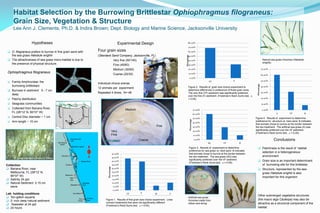
Habitat Selection by Burrowing Brittlestar: Grain Size & Sea Grass Preference
- 1. Habitat Selection by the Burrowing Brittlestar Ophiophragmus filograneus: Grain Size, Vegetation & Structure Lee Ann J. Clements, Ph.D. & Indira Brown; Dept. Biology and Marine Science, Jacksonville University Hypotheses Experimental Design 80.00% 70.00% O. filograneus prefers to burrow in fine grain sand with Four grain sizes 60.00% the sea grass Halodule wrightii (Standard Sand Company, Jacksonville, FL) Percentage 50.00% The attractiveness of sea grass micro-habitat is due to Very fine (50/140) 40.00% Natural sea grass rhizomes (Halodule the presence of physical structure. wrightii). Fine (45/60) 30.00% Medium (30/65) 20.00% 70.00% Ophiophragmus filograneus Coarse (20/30) 10.00% 60.00% 0.00% VF FV 50.00% Family Amphiuridae: the Individual choice arenas Percentage burrowing brittlestars Figure 2. Results of grain size choice experiment to 40.00% 12 animals per experiment Burrows in sediment 5 - 7 cm determine differences in preference of finest grain sizes. Repeated 4 times, N= 48 The very fine (VF) sediment was significantly preferred 30.00% deep over the fine (F) sediment. (Freidman’s Rank Sums test, Patchy distribution = 0.05). 20.00% Seagrass communities 10.00% Collected from Banana River, Medium 70.00% 0.00% FL (28o12’ N, 80o37’ W) A VF B 60.00% Central Disc diameter ~ 1 cm 50.00% Figure 4. Results of experiment to determine Percentage Arm length ~ 10 cm preference for structure vs. bare sand. B indicates 40.00% that animals chose to burrow at the border between Fine 30.00% the two treatment. The artificial sea grass (A) was Very 20.00% significantly preferred over the VF sediment. (Freidman’s Rank Sums test, = 0.05). Fine 10.00% Coarse 0.00% Conclusions SG VF B Figure 3. Results of experiment to determine Patchiness is the result of habitat preference for sea grass vs. bare sand. B indicates selection in a heterogeneous 50.00% that animals chose to burrow at the border between 45.00% the two treatment. The sea grass (SG) was environment significantly preferred over the VF sediment. Grain size is an important determinant 40.00% (Freidman’s Rank Sums test, = 0.05). Collection 35.00% of burrowing site for this brittlestar Percentage Banana River, near 30.00% Structure, represented by the sea- Melbourne, FL (28o12’ N, 25.00% grass Halodule wrightii is also 80o37’ W) 20.00% important for this organism Salinity 24 ppt. 15.00% Natural Sediment 0.15 cm 10.00% sieve 5.00% 0.00% Lab holding conditions VF F V M C Other submerged vegetative structures Ten-gallon aquaria Artificial sea grass 2- inch deep natural sediment Figure 1. Results of first grain size choice experiment. Lines rhizomes made from (the macro alga Caulerpa) may also be connect treatments that were not significantly different ribbon and string. attractive as a structural component of the Seawater at 24 ppt (Freidman’s Rank Sums test, = 0.05). 24 hours habitat.